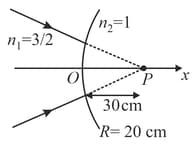Embibe Experts Solutions for Chapter: Geometrical Optics, Exercise 1: Exercise 1
Embibe Experts Physics Solutions for Exercise - Embibe Experts Solutions for Chapter: Geometrical Optics, Exercise 1: Exercise 1
Attempt the practice questions on Chapter 15: Geometrical Optics, Exercise 1: Exercise 1 with hints and solutions to strengthen your understanding. Practice Book for KVPY Aptitude Test - Stream SA Physics solutions are prepared by Experienced Embibe Experts.
Questions from Embibe Experts Solutions for Chapter: Geometrical Optics, Exercise 1: Exercise 1 with Hints & Solutions
A man is sitting in a room at from a wall wants to see the full height of the wall behind him high and away from the facing wall . What is the minimum vertical length of mirror on the facing wall required for the purpose?
A flint glass prism and a crown glass prism are to be combined in such a way that the deviation of the mean ray is zero. The refractive index of flint and crown glasses for the mean ray are and , respectively. If the refracting angle of the flint prism is , what would be the refracting angle of crown prism?
A plane mirror is moving with velocity . A point object in front of the mirror moves with a velocity . Here is along the normal to the plane mirror and facing towards the object. The velocity of the image is:
Alight wave travels from glass to water. The refractive index for glass and water are and , respectively. The value of the critical angle will be
When a beam of light goes from denser medium to rarer medium , then it is generally observed that magnitude of angle of incidence is half that of angle of refraction. Then magnitude of incident angle will be (here )
The image for the converging beam after refraction through the curved surface is formed at

A thin linear object of size is kept along the principal axis of a convex lens of focal length . The object is at from the lens. The length of the image is
A convex lens is cut into two parts in different ways that are arranged in four manners, as shown. Which arrangement will give maximum optical power?
